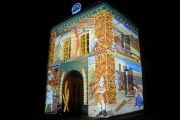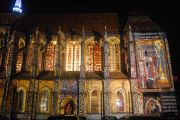For six months, every night the monuments of Chartres are bedecked with shimmering colours. A spectacular free show that enhances the historical heritage of the city.
[ Practical ]
Getting there
- By road
90 km from Paris on autoroutes A6b and A10.
- Train
TER train from Paris Montparnasse to Chartres. The journey takes around one hour.
Lodging
Le Grand Monarque
Mercure Chartres Centre
Hôtel Châtelet
Ibis Chartres Cathédrale
Le Parvis
La Maison Paradis
Restaurants
Le Georges
La Courl
Les Feuillantines
Le Moulin de Ponceau
Le Parvis
Esprit Gourmand
Chartres en Lumière
2019 edition from April 27th to October 12th.
Good to know
Sold €19.50 , the “Chartres Pass” gives free access to nine of the city’s monuments and museums, free guided tours of the city and of the cathedral and discounts on various activities.
Information
Chartres tourist office
Tel : 0237182626
www.chartresenlumieres.com
For centuries, Chartres has attracted pilgrims and visitors with its cathedral, a masterpiece of Gothic architecture. From now on, the illumination of the city’s monuments gives another reason to get there and justify another trip if you have already been there. Named “Chartres en Lumières”, this daily event launched in 2003 grew in importance year after year and today 23 buildings are illuminated from dark to 1am.
However, the word “light show” is probably better to describe what you are going to see. Indeed, most of the buildings are not only coloured by light but covered with videos, animated scenes or still images having a link with their history and their past or present function. Moreover, some of these illuminations are accompanied by music.
Landmark of the city, the cathedral’s walls host three distinctive illuminations. On its grandiose façade parade the kings and famous legendary or real people who marked its history. On the south portal, creepers, flowers, birds as well as Adam and Eve appear to the rhythm of Bach’s famous organ piece - the Toccata -, an allegory symbolising the Tree of Life. As to the south portal it is bedecked with saturated colours in the style of illuminated manuscripts that seem to bring back to life the polychrome statues.
Behind the cathedral, the Fine Art Museums - formerly the bishop palace – is entirely illuminated. On the main façade, Polynesian objects, shells, statues and other works of art come one after the other to the rhythm of songs of the Marquise Islands in reference to the collection of Oceanian works that governor Louis-Joseph Bouge brought back and bequeathed to the museum in 1970. At the same time, the back façade is covered by a strange gathering of rhinoceroses, giraffes, elephants, sailing boats, locomotive and farming equipment representing items of the collections of the museums of Chartres.
Oldest wing of the city hall, the 17th century Hôtel Montescôt pays homage to the architects from Greek to modern times. A Roman temple appears on the façade, soon replaced by a Gallo-Roman villa, then come the watchtowers of a Medieval castle followed by a Baroque palace….

 Halle aux Grains © T.Joly Halle aux Grains © T.Joly
|
Thanks to the magic of lighting, the former Marceau college is transformed into a Portuguese Episcopal palace adorned with azulejos in order to remind Chartres is twin city of Evora, by the way the name given to the square where stands this building.
Built on the square where was once held the region largest grain market, the Halle aux Grains – a former storehouse for grains – is covered with allegories and sowing and harvesting representations inspired from a famous 15th century manuscript : “The Very Rich Hours of the Duke of Berry”.
On the Sainte Foy chapel, animated scenes feature an exhibition of furniture, objects, antique paintings porcelain dolls, miniatures cars and toys from many eras appearing and disappearing in front of the audience to the beat of an auctioneer’s hammer. A reminder of the unusual destiny of this building that was made an auditorium at the time of the Revolution and then became the city auction hall.
Also in the upper town, the monumental multimedia library - originally the town main post office -, is covered with mosaics, flower and women representations echoing the Art Deco and Art Nouveau styles of its architecture. Opulent building erected during the Second Empire, the theatre is bedecked with intense and deep colours while white figures dance on the façade accompanied by a musical composition based in Italian operas excerpts.
As to the Saint Aignan church, it is illuminated by a fresco featuring famous 19th century painters like Toulouse Lautrec or Renoir in order to remind that its interior was repainted at this time.
In the lower town, the gem of this night stroll is Saint Pierre church, last remain of a cast abbey built from the 11th to the 13th century.

 Saint Pierre Church © T.Joly Saint Pierre Church © T.Joly
|
Combining screening of fresco-like images and stained glass windows lighted from the interior, it looks like a reliquary shrine whose enamels tell the story of Fulbert, the bishop who started to build the cathedral. This church is indeed the presumed site of his grave.
Nearby, the bridges spanning over the Eure are covered with texts telling their history while the illuminations of the washhouses standing along the river evoke the fishes, the flora, the washerwomen and the mills.
There are also illuminations featuring nobles and craftsmen who lived in Chartres in the past on the houses of two streets linking the upper and the lower towns, the Rue Saint Pierre and rue des Ecuyers.
It takes around two and half hours to see all illuminations without having to hurry. Distances are short, but if you are tired a little train runs between the monuments. Lastly, every year ‘Chartres en Lumière” ends with a dazzling two nights of celebration for young and old alike featuring numerous theatre, dance and music performances throughout the city.
April 03, 2019
Thierry Joly 

|



